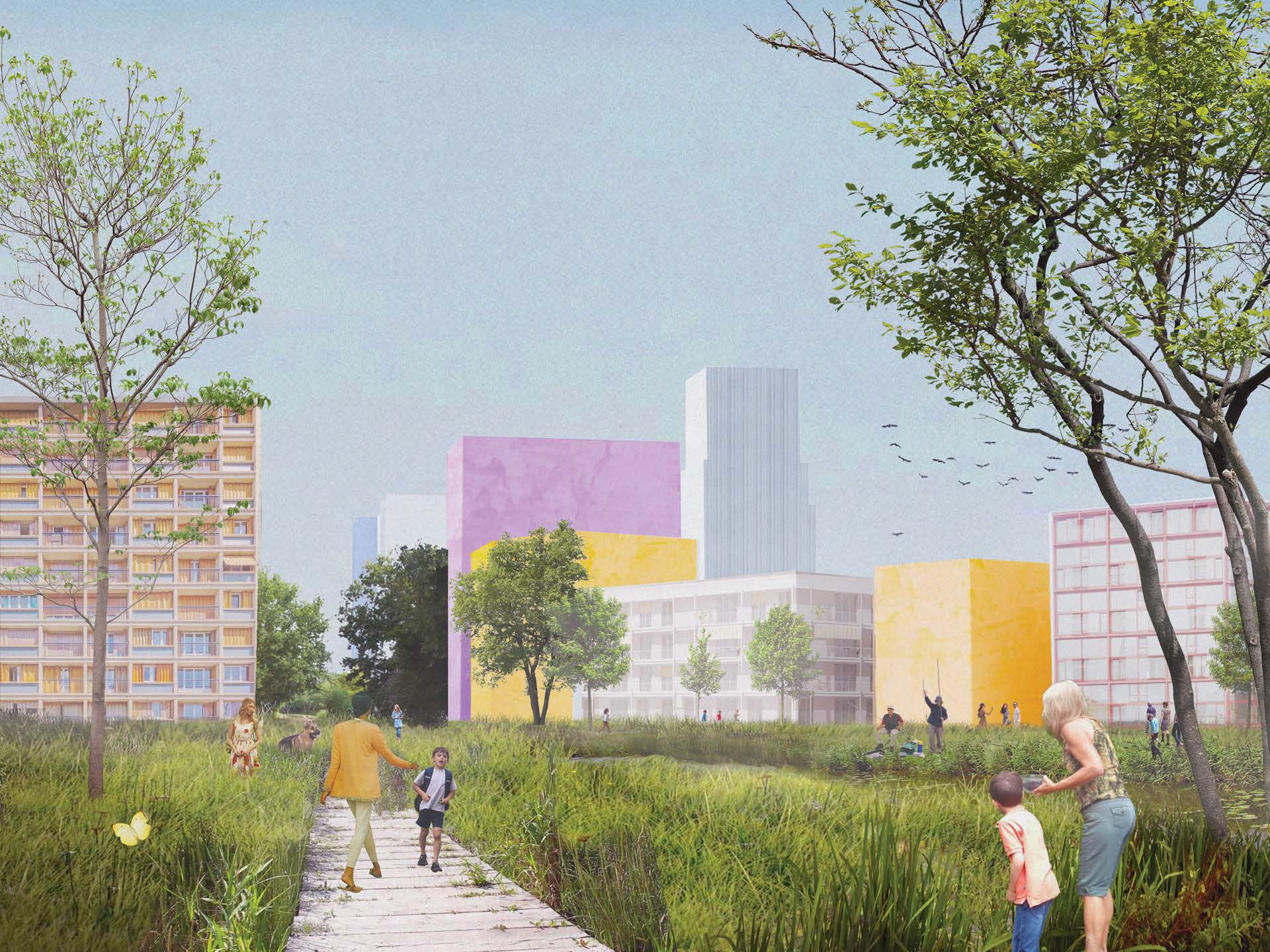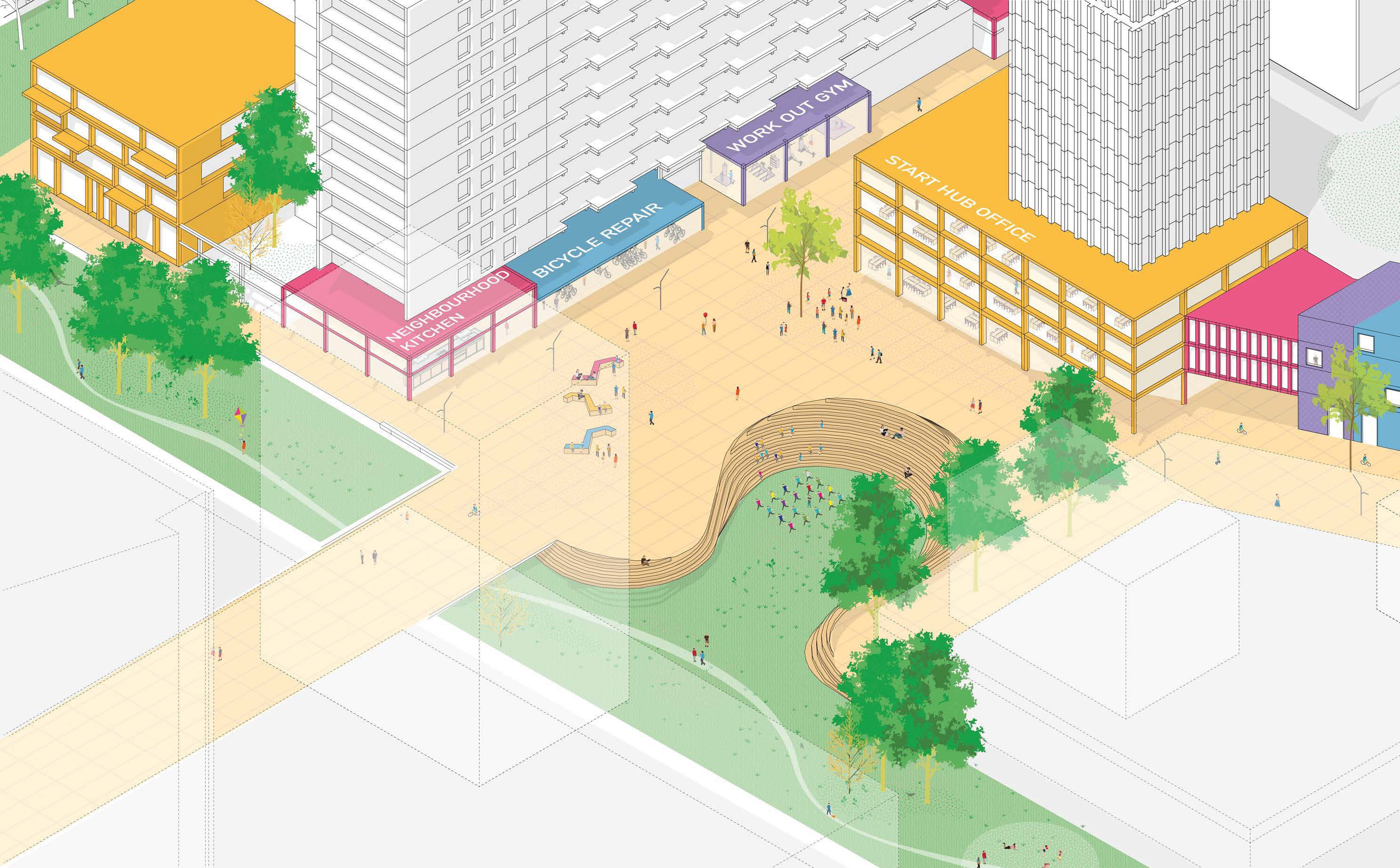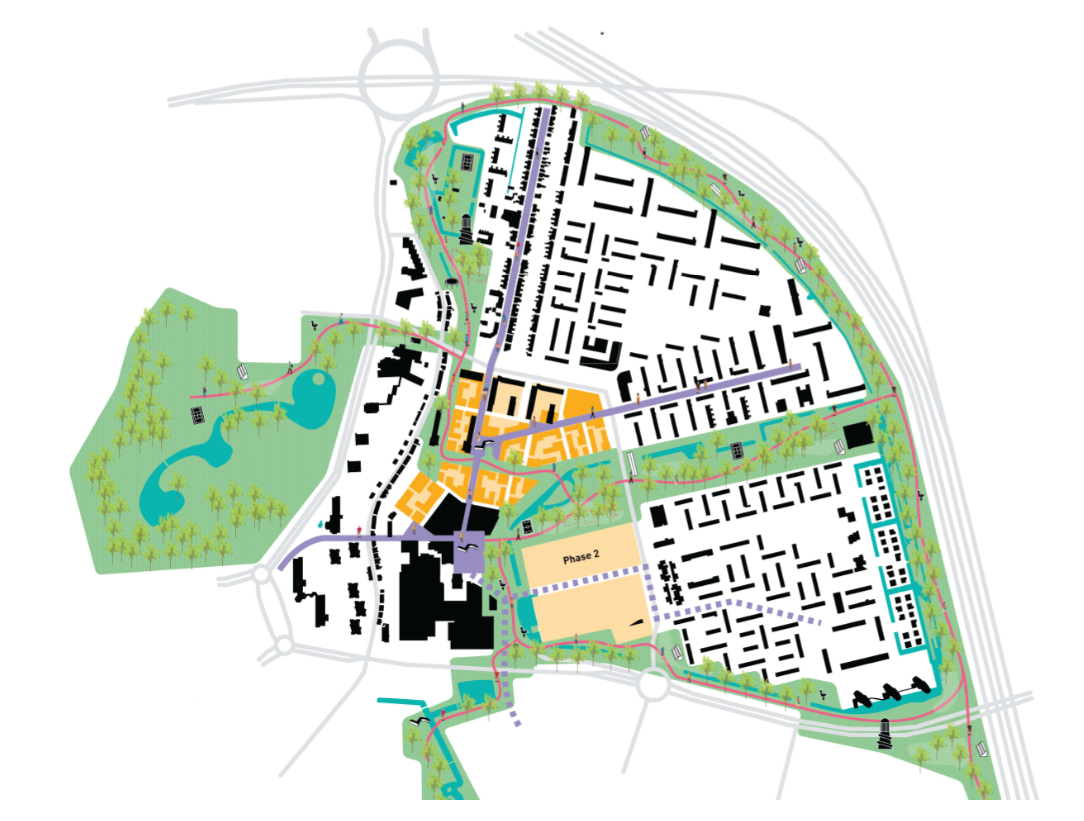Semi-Urban IJsselmonde: Social Production by Restructuring Suburbia

Semi-Urban IJsselmonde
Render: Team Semi-Urban IJsselmonde
This runner up proposal for Europan 15’s Groot IJsselmonde site in Rotterdam presents a semi-urban redevelopment of the heart of IJsselmonde. This centre has sufficient local, urban processes to autonomously maintain socially developed spaces, and a lush and active new neighbourhood park for inhabitants to enjoy. It aims to achieve the best of both worlds, drawing green living and social interaction together. Through strategic urban principles that include density, porosity, and adaptability, it generates semi-urban spaces. These spaces are resilient to change, encourage social interaction, and complement Rotterdam’s urbanity with calmness and serenity.
Semi-Urban IJsselmonde Team Interview
Videography: Kristel Kuipers; Interview: Cullo Studio for AIR
Sub-Urban IJsselmonde
Groot-IJsselmonde is a district with a quiet and gentle pace. Vehicular infrastructure dominates its different neighbourhoods and its green corridors provide refuge that positively contrast with the bustle of the city. However, the city around it outpaces this tranquility.
As such, Groot-IJsselmonde is in need of an upgrade. Its urban structure has never been completely developed according to its original masterplan, leaving some of its spaces underdeveloped. In combination with (relatively) recent expansions into the green structures, large swathes of space lie in a twilight zone. These are not quite developed areas, nor are they qualitative public spaces. The neighbourhood’s accommodation of vehicular traffic is detrimental to the formation of a cohesive and complete network of slow traffic. It’s easier and more pleasant to get from one neighbourhood to the next by car, rather than by bike, or on foot.
Yet underneath the surface of these issues lies a more significant challenge. As the brief mentions, IJsselmonde lacks a certain urban dynamism. This is typical for “peripheral post-war districts ..(-).. due to their monofunctional setup and the lack of new spatial developments. Support for communal services is under pressure because of the ageing population and the decrease in the number of inhabitants per house.” This lack of density, facilities, and entrepreneurship result in a very low social productivity. In ‘The production of space’, the sociologist Henri Lefebvre describes space as a social product, produced by local social practices and values. Each society produces its own space by activating and appropriating the (urban) landscape through local culture and everyday practices. This process is clearly visible in cities where a variety of life is played out right in front of one’s own doorstep.
In sub-urban neighbourhoods like IJsselmonde, these local practices and values are exchanged for air, light and space, resulting in open but often inactive spaces. It is in need of a self-sustaining system of social production to enliven its many spatial qualities. By developing the heart of IJsselmonde into a semi-urban typology, with enough local urban processes to autonomously maintain socially developed spaces, and a lush and active new neighbourhood park for inhabitants to enjoy, we aim to achieve a best of both worlds where green living and social interaction come together.

Developing corridors into a lush neighbourhood park
Render: Team Semi-Urban IJsselmonde
Towards a semi-urban IJsselmonde
A productive semi-urban IJsselmonde supports a socially interactive community with a local economy by providing sufficient density to attract businesses, local shops and facilities. New inhabitants are attracted by providing various housing typologies in a lively and interactive neighbourhood. This development of semi-urbanity builds on the existing qualities of IJsselmonde. Plenty of space to develop, green qualities to elaborate on and a handful of businesses that thrive: we see these qualities as the foundation for future development. This foundation allows us to develop IJsselmonde as a social space that feels familiar to the current inhabitants and allows us to tap into the social, spatial and economic capital already present in the district.
This means providing different strategies on different scales:
L – Provide structure
On the scale of the strategic site (and slightly beyond) we propose multiple structural interventions that provide the framework for new developments.
M – Density and porosity
On the scale of the project site the different frameworks intersect with local idiosyncrasies. By specifically designing certain elements, we plant the seeds for social productivity and guarantee interaction with the context.
S – Diversity and adaptability
On the block scale we set ratios and guidelines that will stimulate social productivity with a diverse mix of functions and inhabitants. Guidelines allow for envisioned qualities to develop without dismissing equally plausible but unpredicted alternatives.
This proposal helps to facilitate “the staging of uncertainty; it will no longer be concerned with the arrangement of more or less permanent objects but with the irrigation of territories with potential; it will no longer aim for stable configurations but for the creation of enabling fields that accommodate processes that refuse to be crystallized into definitive form; ..( – )..about the “more” and the “modified” (Koolhaas, 1995).

Additional residential units or office space can be added above
Render: Team Semi-Urban IJsselmonde
L. Provide structure – neighbourhood
Groot-IJsselmonde is undergoing continuous change, but many interventions since the masterplan appear haphazard and without a clear goal. The answer is not a new master plan that attempts to force these developments into a rigid urban form that neither delivers the envisioned outcome unless executed perfectly, nor provides flexibility for an uncertain future. Instead, we propose a strategic framework that guides developments by allocating space and setting goals that can be achieved in a variety of ways.
Connect the neighbourhoods to the commercial core
The commercial centre has never fully occupied its allocated space. Over time, this space has slowly been filled with disorderly developments. As a result, navigating the area as a pedestrian or cyclist is challenging. The in-between zone of bungalows, swaths of parking and prefabricated buildings form a strong separation between the commercial centre and the different neighbourhoods. These underdeveloped spaces are activated with a dense programme of housing, workspaces, and public functions. A network of high-quality public space forms a connective urban tissue between centre and the neighbourhoods.
Develop urban promenades
A series of urban promenades form the centrality of the new development. With a lightly programmed public space, room for pedestrians and cyclists and active plinths, the promenades bridge the distance between commercial core and quiet neighbourhoods.
Relocate functions from the green corridor to the new urban tissue
Green corridors have been one of the main design strategies of the original Groot-IJsselmonde plan. The corridors function as physical separators between the different neighbourhoods. Over time, development has taken place in these corridors. The corridors have become a disconnected patchwork of low-quality green space with little function. By giving the haphazard developments a place in the new urban tissue, the corridor can become a more cohesive green public space.
Develop the corridors into a lush neighbourhood park
By (re)wilding, designing and programming the fragmented green corridors transforms into a continuous loop, a new neighbourhood park comes to life. A park that connects neighbourhoods, inhabitants and ecological hotspots. Just like the rest of the world, Groot-IJsselmonde will increasingly be confronted with the consequences of climate change such as peak rainwater discharge, and the urban heat island effect. The park can play a major role in addressing these issues.
M. Create density and porosity – project site
On the scale of the project site, the different frameworks intersect with local idiosyncrasies. By specifically designing certain elements, we plant the seeds for social productivity and guarantee interaction with the context.
Divide plots to create a porous and hierarchical network of streets
The district devoid of everyday city-life would benefit from a form a network of readable public space, with quality and a sense of safety. New developments will therefore follow the to be formed network of streets. The new urban tissue becomes a permeable membrane between existing location. By arranging the plots in a loose grid structure with varying distances a fine mesh of streets, with emphasis on the interconnecting promenades develops. This mesh improves accessibility and stimulates cycling and walking.
Concentrate public functions in the plinths along the promenade
By concentrating publicly accessible and lively functions around the promenade a mutual benefit arises. The activity in the plinth makes the street more pleasant and popular for walking. And the pedestrians that walk the promenade become a free audience for the functions in the plinth.
Everything comes together on the central square
The confluence of landscape and urbanity brings both elements to greater heights. The central square features a multi-use landscaped seating element. It can provide seating for events, serve as local meeting point and function as entrance to the landscape network.
Towards a new mobility
IJsselmonde is currently mostly car-oriented. Although this makes the neighbourhood accessible, it also results in streets with little respect to human scale or spatial quality.In order to develop pleasant streets, the newly developed spaces are largely inaccessible to cars. Developments along the fringes access their parking garage from outside the project area and inhabitants in the central part park their car in a strategically located mobility hub. This hub stimulates inhabitants to use the existing public transport services and to share cars, bikes and e-vehicles. Although still dependent on the centre, the combination of new local functions and activities and the stimulation of new forms of mobility will make Groot-IJsselmonde appealing to a younger ‘carless’ generation.

Semi-Urban Masterplan
Render: Team Semi-Urban IJsselmonde
S. Stimulate diversity and adaptability
Without explicitly defining the programme of IJsselmonde’s ‘new economy’, we define the spatial frameworks that allow this (or any vital local) economy to develop. These frameworks aim to build a sustainable mix of housing, as well as socially productive and economically productive functions. They provide the flexibility to catalyse market initiatives, while simultaneously protecting desired qualities or values. Through a combination of space provision and setting of ratios, a desirable type of development is stimulated without dismissing equally plausible but unpredicted alternatives. Like a painting by numbers game, we provide the spaces that can be filled in and define the rules and percentages that will guarantee a desirable composition. In this manner, buildings will provide for both current and future inhabitants of Groot-IJsselmonde.
Diversity in unit sizes leads to diversity in functions
Different people doing different things at different times is essential for social productivity. In order to attract this diversity without superimposing specific functions, we propose different sized units that a developer, collective or end user is free to fill in according to their (or the market’s) needs. The different sizes allow inhabitants of IJsselmonde to start and develop their own enterprise within the neighbourhood.
Allocate set amounts of different sized units that can be freely distributed over the plot
Each plot is allocated a set amount of different sized units that can be freely distributed over the first 3-4 stories of the plot, guaranteeing a lively mix of users in close proximity to the public space.
A certain distribution of functions
To prevent plots from being developed entirely with housing, the first 3-4 stories have a set distribution of functions. Due to the level of abstraction of this rule, it is easily adjusted to market demands. This can be accomplished with a ratio of roughly 15% socially productive functions (e.g. schools, doctors, nursing homes). In addition, 35% economically productive functions (e.g. gyms, car repairs, design offices). The remaining 50% can be residential.
Offices and residential development may be added on top of the plinth
Above the first three to four floors, developers may choose to add additional residential units or office space to further solidify their business case. These additions have to be realised with a setback to guarantee sunlight and human scale at street level.
Building height respects human scale and adapts to the surroundings
The height profile of the urban layer is fixed, but it offers flexibility: three to four layers. This height ensures that it is possible to create qualitative living conditions in the adjacent streets. The height of the additional developments respond to the surroundings; the maximum height must be between the height of the Koningswaard tower, and the remaining blocks along De Groene Tuin.
Gijs de Haan (NL) – Architect, Urbanist; Corne Strootman (NL) – Landscape Architect; Vincent Peters (NL) – Landscape Architect
Semi-Urban IJsselmonde Runner Up Groot IJsselmonde


